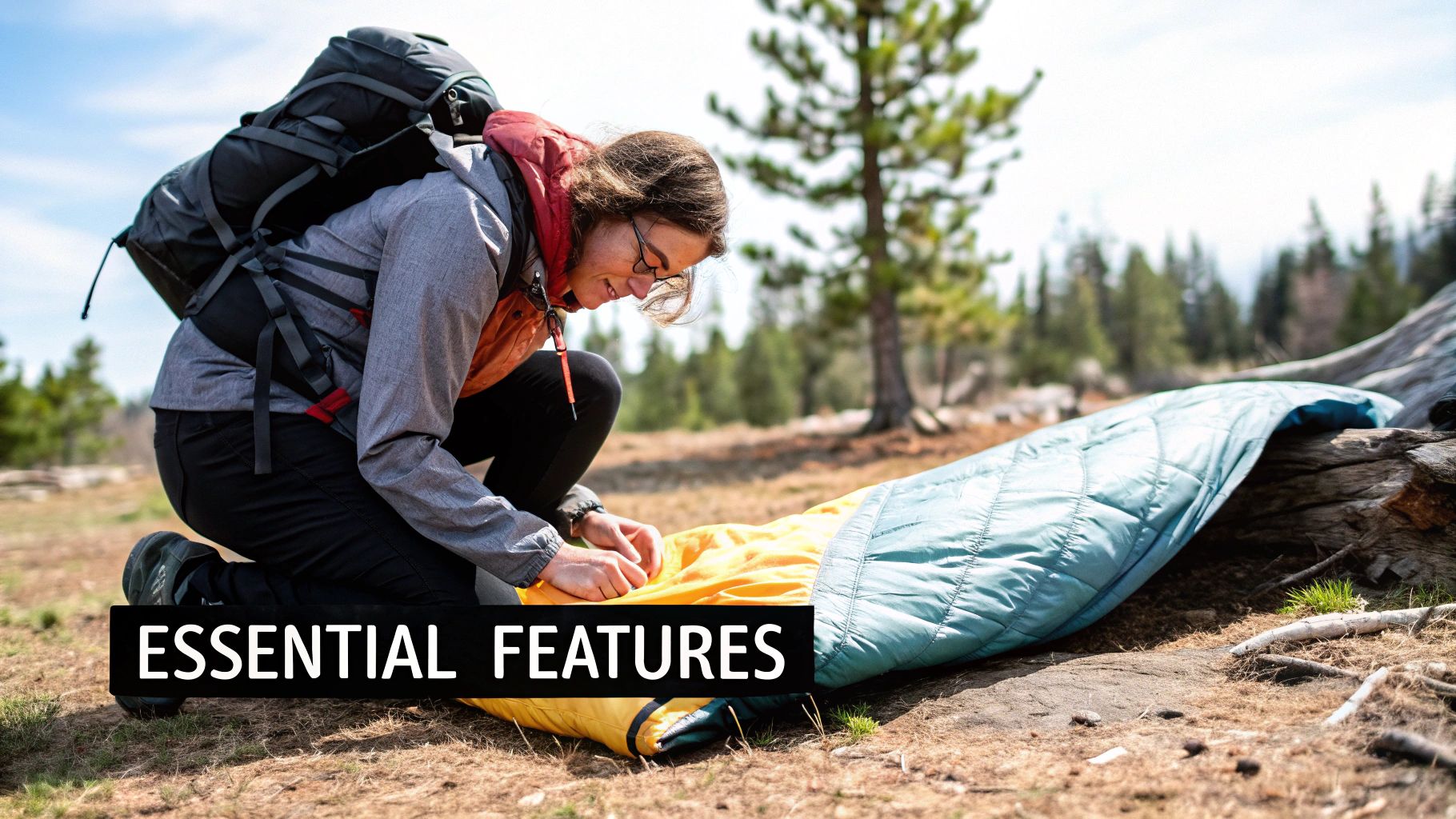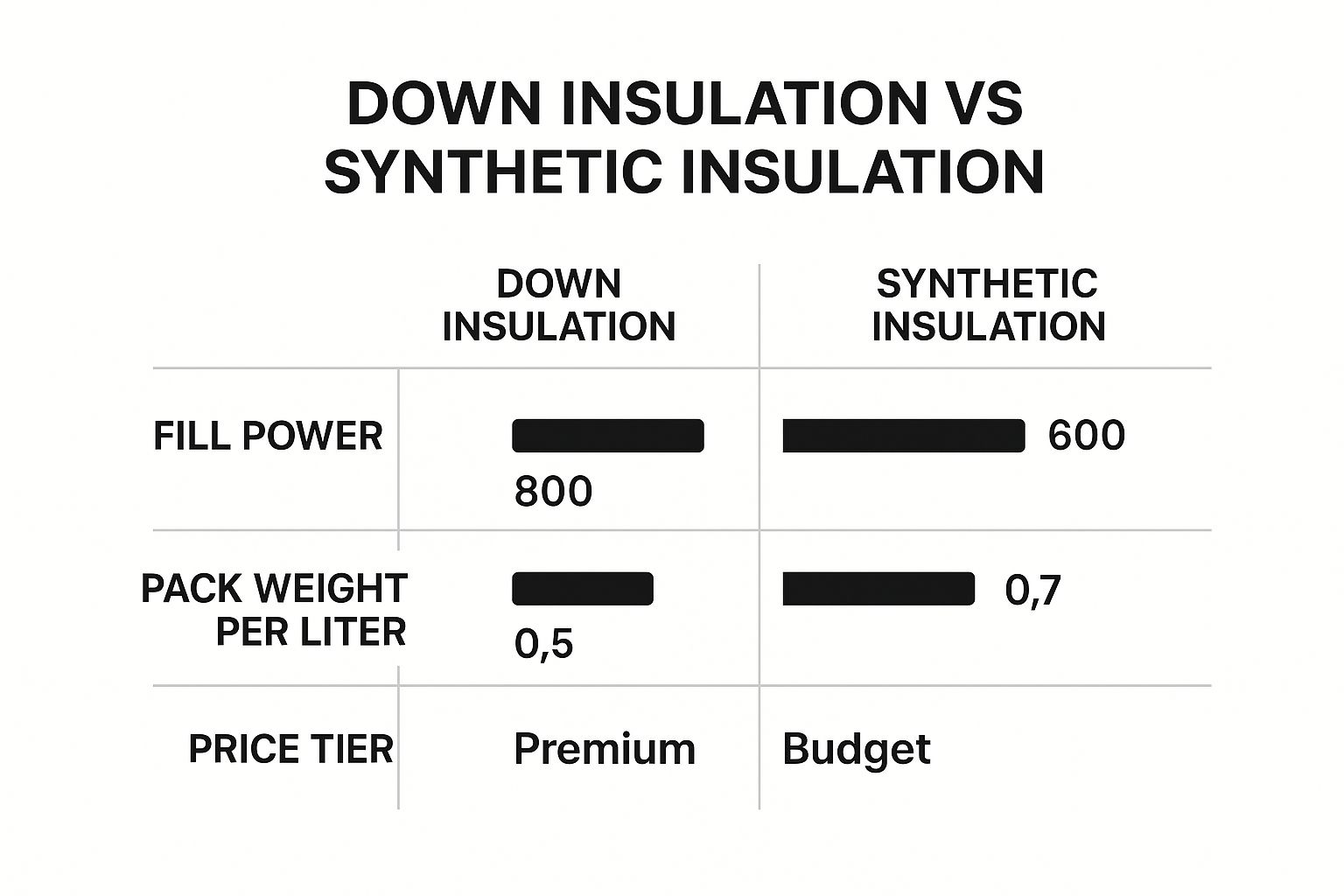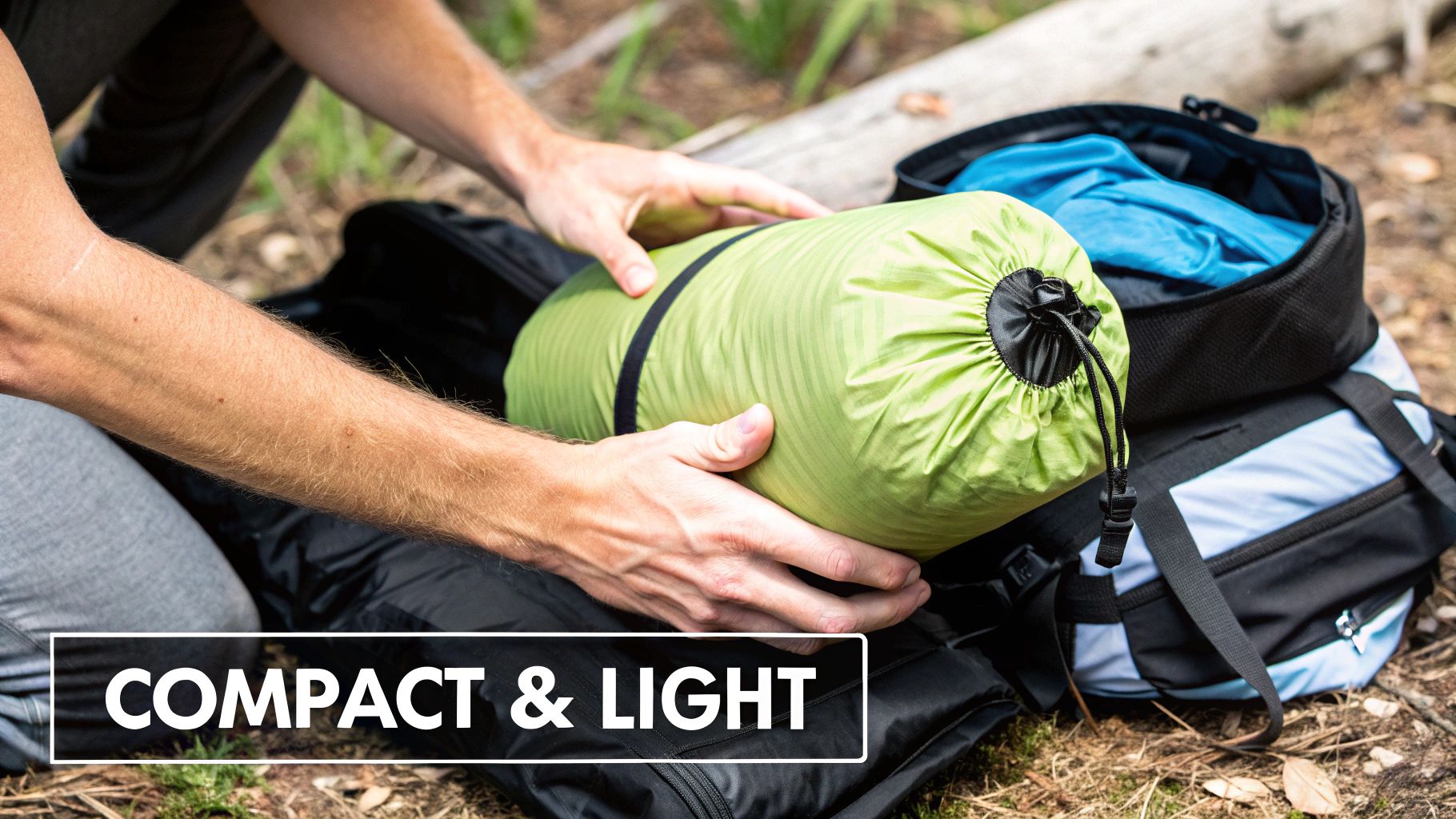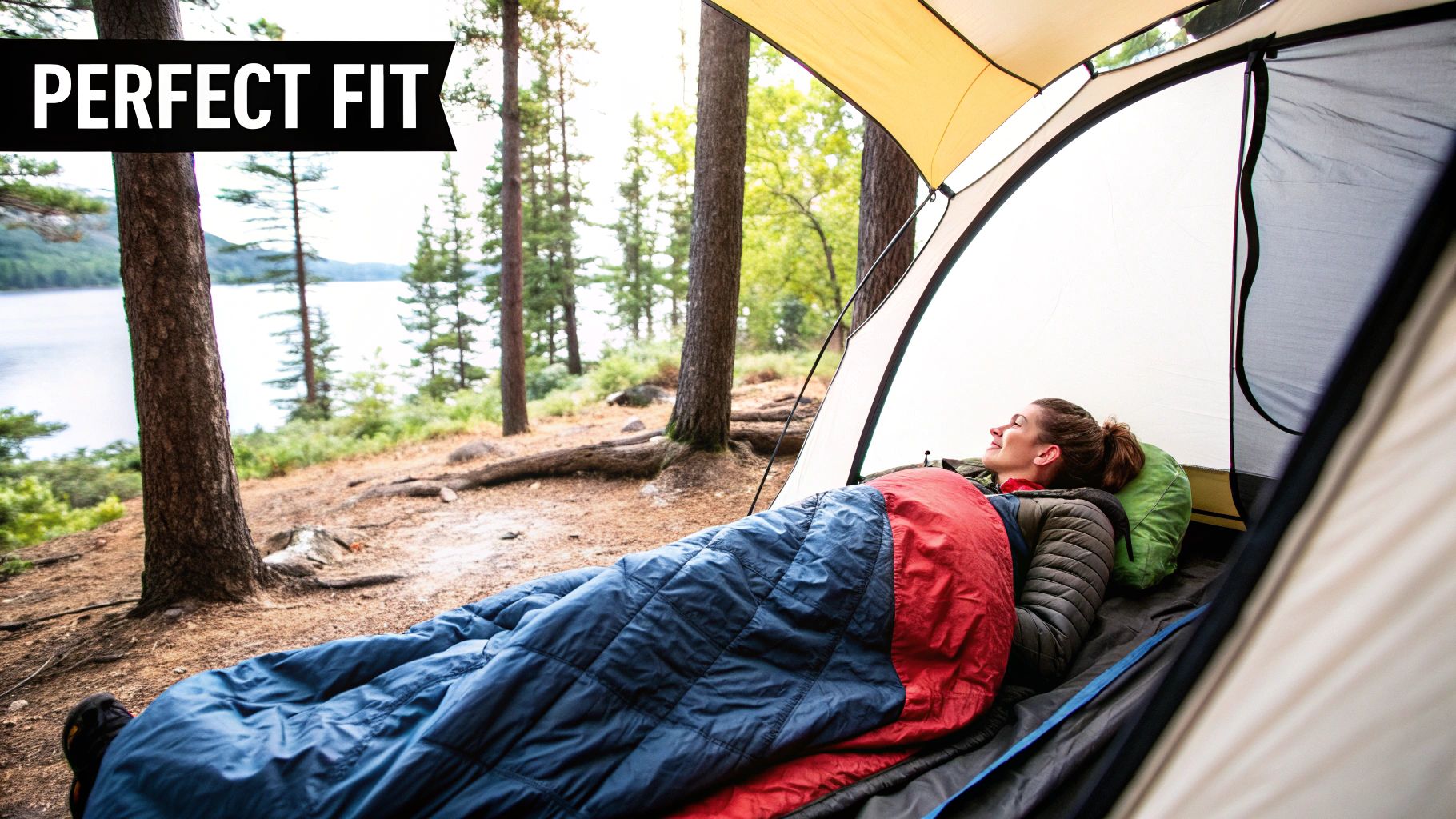A 0 degree backpacking sleeping bag isn't just another piece of gear—it's your first line of defense against the kind of cold that can turn an adventure into an emergency. But here’s the most common mistake people make: assuming that 0°F rating means you'll be warm and toasty at zero degrees.
Nope. Think of it more as a survival rating. It’s the absolute lowest temperature you can endure a night in that bag. For real, actual comfort, you need to understand what that number truly means.
Why Your Sleeping Bag Is Your Most Critical Winter Gear
Picture this: The stars are popping out of a black velvet sky, the air is so still you can hear your own heartbeat, and a fresh blanket of snow muffles the world in silence. It’s a perfect winter night. Except you're in your tent, shivering so hard your teeth are chattering, just waiting for the sun to come up.
That trusty 30-degree bag that was perfect all summer? It’s completely useless now. This is a classic, and frankly miserable, rite of passage for backpackers who underestimate just how brutal the cold can be.
When you're heading out into sub-freezing conditions, choosing the right sleeping bag isn't about luxury; it's the single most important safety decision you'll make. A good 0 degree backpacking sleeping bag is your personal life-support system. It’s a warm, life-preserving cocoon that literally stands between you and hypothermia. This is the one piece of gear you absolutely cannot skimp on.
Understanding the 0 Degree Myth
Let's bust this myth once and for all. That 0°F rating doesn't mean you'll be lounging comfortably when the mercury hits zero. That number is a standardized limit—the temperature at which an "average" person can survive the night without immediate harm.
For most of us, true comfort in a 0°F bag is usually found somewhere closer to 10-15°F.
This guide is here to help you find the perfect cold-weather companion. We’re going to break down:
- How to actually read and interpret temperature ratings.
- The age-old battle: down vs. synthetic insulation.
- The key features that make or break a bag's warmth.
- The delicate dance between weight, packability, and durability.
The boom in outdoor recreation has created a massive market for high-tech gear. In fact, the global camping sleeping bags market was valued at a whopping USD 13.48 billion in 2024 and is expected to soar to USD 24.29 billion by 2032. This explosive growth is driven by demand for high-performance gear like mummy bags, which are champions of thermal efficiency. If you're a data nerd, you can read the full analysis of the sleeping bag market to see where things are headed.
Remember, a sleeping bag doesn't create heat—it only traps the heat your body produces. The secret to a warm night is going to bed with a full stomach, a warm body, and the right gear.
Want an easy way to boost your bag’s performance? Tossing in an ultra-light portable fleece sleeping bag liner can add a few precious degrees of warmth.
Our goal here is to arm you with the knowledge to step out into the cold with confidence, knowing you've got exactly what you need to sleep soundly and, most importantly, safely.
Decoding Sleeping Bag Temperature Ratings

Walking into the world of sleeping bags can feel like trying to crack a secret code. You see numbers like 0°F, 15°F, and 30°F plastered everywhere, but what do they actually mean for a night in the wild? Here's the inside scoop: a sleeping bag's temperature rating isn't a guarantee—it's more of a scientific guess.
Think of it like the "miles per gallon" sticker on a new car. That number was achieved under perfect lab conditions. Your real-world mileage will swing based on how you drive, if you're hauling a heavy load, or if you're stuck in traffic. It's the same deal with a sleeping bag. That number on the tag is just the beginning of the story.
Thankfully, most reputable outdoor brands have ditched the guesswork and now use a standardized system called the EN/ISO 23537 rating. This gives us a much more honest look at a bag's performance by breaking it down into a few key metrics. Getting a handle on these is your first step to making sure you don't spend a beautiful, starry night shivering miserably.
The Three Magic Numbers: What EN/ISO Ratings Really Mean
The EN/ISO test gives you a far clearer picture of what you’re buying. Instead of a single, often misleading number, you get a realistic range that helps you match the bag to your body and the conditions you expect.
Let's break down the three ratings you need to know:
- Comfort Rating: This is the temperature where a "standard" cold sleeper (often modeled after an average woman) can sleep comfortably without feeling chilled. If you're someone who is always cold, this is your number. Pay attention to this one.
- Limit Rating (or Lower Limit): This is the sweet spot for a "standard" warm sleeper (usually modeled after an average man), who can sleep curled up for eight hours without waking up from the cold. A 0 degree backpacking sleeping bag almost always gets its main number from this rating.
- Extreme Rating: Honestly? Just ignore this number. It's a survival rating, plain and simple. It tells you the temperature at which you could survive for six hours without dying of hypothermia, but frostbite is a very real possibility. It has absolutely nothing to do with comfort.
So, when you see that shiny "0°F" bag, you now know it's referring to the Limit rating. A naturally warm sleeper might be fine, but if you run cold, you'll be pushing your luck and feeling every bit of that freezing air.
For a cozy night's sleep, here's a solid rule of thumb: pick a bag whose comfort rating matches the lowest temperature you actually expect to face. For a 0°F bag, this often means true comfort is found closer to 10-15°F.
Why You Are the Most Important Factor
Here’s the catch with all this science: the ratings are determined using sophisticated thermal manikins in a controlled lab. The problem? You're not a robot. You're a living, breathing, heat-generating human, and your personal physiology is the biggest wild card of all.
A bunch of personal factors can completely change how warm a bag feels:
- Metabolism: Do you run hot or cold? We all know someone who is a human furnace, while others are perpetually chilly. Your personal thermostat makes a huge difference.
- Gender: On average, women tend to sleep colder than men due to differences in metabolic rates and body fat distribution. This is why many brands design women-specific bags with extra insulation in the torso and footbox.
- Fuel in the Tank: Going to bed hungry or dehydrated is a recipe for a cold night. Your body needs calories to produce heat, so a warm meal and plenty of water before you turn in can work wonders.
It's a System, Not Just a Bag
Finally, your 0 degree backpacking sleeping bag is only one piece of the puzzle. It's the star player in your "sleep system," but the supporting cast is just as important for staying toasty when the mercury drops.
Your sleeping pad is the unsung hero here. The cold, hard ground is a massive heat sink, and it will suck the warmth right out from under you if your pad isn't up to the task. For winter conditions, you need a pad with an R-value of 5 or higher. No exceptions.
And what you wear to bed matters. A fresh, dry set of base layers (wool or synthetic—never, ever cotton) and a warm beanie will trap precious body heat. By thinking about your body, your pad, and your layers, you can move beyond the numbers on a tag and build a sleep system that truly keeps you warm.
Choosing Your Insulation: Down vs. Synthetic
Alright, let's get into the great debate, the heavyweight championship of the sleeping bag world: down versus synthetic. Picking the right insulation for your 0 degree backpacking sleeping bag is a lot like choosing your adventure vehicle. Are you going for the sleek, ultralight sports car or the rugged, go-anywhere 4x4? Both will get you to your destination, but they handle very differently along the way.
This isn't about which one is "best" overall. It's about what's best for you and the kind of backcountry you'll be exploring. Your decision really comes down to a few key things: the weather you expect, what you're willing to spend, and how much you baby your gear.
The Case for Down Insulation
Down is the sports car, no question. We're talking about the soft, fluffy plumage from geese or ducks, and its reputation for performance is well-earned. When it comes to the warmth-to-weight ratio, nothing else comes close. A down bag will pack down to a ridiculously small size and weigh less than a synthetic bag of the same temperature rating. For backpackers, where every ounce feels like a pound by day three, that’s a huge deal.
Think of it this way: each tiny down cluster is a complex, three-dimensional puffball with thousands of filaments. These create countless little air pockets that trap your body heat with incredible efficiency. We measure this efficiency using fill power, which usually ranges from 650 to 950+.
- Higher Fill Power (800+): This is the premium stuff. The down clusters are bigger and loftier, meaning they trap more heat with less material. The result? An insanely warm, light, and compressible bag.
- Lower Fill Power (650-750): Still fantastic insulation! The bag will be a bit heavier and won't pack down quite as small as its high-end cousin, but it’s often much easier on the wallet.
But even a finely tuned sports car has a weakness, and for down, it’s water. When traditional down gets wet, those amazing little clusters collapse. They completely lose their loft and their ability to insulate, leaving you with a cold, soggy clump that takes an eternity to dry. Thankfully, modern tech has given us hydrophobic down, which is treated to resist moisture and dry out faster. It’s a game-changer, but it’s still not as bombproof in a downpour as synthetic.
The Case for Synthetic Insulation
If down is the sports car, then synthetic is your trusty, all-terrain 4x4. It’s made from fine polyester fibers engineered to copy the heat-trapping structure of down. While it can’t quite match down's feathery weight and compressibility, synthetic insulation has a superpower: it laughs in the face of moisture.
Get a synthetic bag damp, and the fibers will resist absorbing water, holding onto their loft and continuing to keep you warm. This makes it an absolute workhorse for trips in consistently wet and humid places—think the Pacific Northwest rainforests or a soggy spring trek in the Appalachians.
The real magic of synthetic is its sheer reliability. It’s the undisputed champion for adventurers who need gear that performs no matter how wet it gets, even if it means carrying a few extra ounces.
On top of that, synthetic bags are generally cheaper and hypoallergenic, making them a fantastic choice if you’re new to winter camping or just don't want to drop a ton of cash. They're also tougher and easier to clean. The trade-off? They're bulkier and heavier, taking up precious real estate in your pack.

This quick snapshot really tells the story. Down wins on pure performance and weight, but that efficiency comes with a higher price tag.
To make things even clearer, here’s a quick head-to-head comparison to help you figure out which camp you belong to.
Down vs. Synthetic Insulation at a Glance
| Feature | Down Insulation | Synthetic Insulation |
|---|---|---|
| Warmth-to-Weight | Exceptional. The lightest option for the warmth. | Good. Heavier and bulkier for the same warmth. |
| Compressibility | Excellent. Packs down incredibly small. | Fair. Takes up more space in your pack. |
| Performance When Wet | Poor (unless hydrophobic). Loses loft and warmth. | Excellent. Insulates even when damp. |
| Durability | Very durable if cared for properly. | Very durable and more forgiving of rough use. |
| Cost | High. A premium investment. | Lower. Much more budget-friendly. |
| Maintenance | Requires special washing and careful handling. | Easy to wash and care for. |
So, while down is the clear winner for ultralight, dry-condition performance, synthetic is the reliable workhorse that won't let you down when the skies open up.
So, How Do You Choose?
Look, this all comes down to your personal adventure style. There's no pop quiz at the end of this. Just ask yourself a few honest questions:
- Where am I actually going? If you mostly camp in dry, cold places like the high desert or the Rockies, down is a fantastic choice. If your trips often involve rain, mist, or heavy condensation, synthetic’s reliability is pure gold.
- What’s my budget? A top-tier down bag is a serious investment. Synthetic gets you out there and keeps you warm for a whole lot less money.
- Am I an ounce-counter? For thru-hikers and ultralight fanatics, the weight and space saved by a high-fill-power down bag are often the most important factors. Period.
- How do I treat my gear? Be honest. If you’re the type to stuff your bag away damp and forget about it, the forgiving nature of synthetic is probably for you. Down requires a bit more TLC to live a long and lofty life.
At the end of the day, there is no wrong answer. Both down and synthetic will keep you warm and safe in a 0 degree backpacking sleeping bag. The trick is to pick the one that fits your adventures, not someone else's.
Key Features of a Great 0-Degree Sleeping Bag

Once you've sorted out the temperature rating and insulation type, the real magic—or misery—is in the details. The little design features are what separate a truly great bag from a "good enough" one that'll have you shivering by 2 a.m.
These aren't just bells and whistles. They’re a complete system designed to lock in your precious body heat and fight back against the cold. Think of it like weather-stripping the doors and windows of your own personal warmth fortress. A great 0-degree backpacking sleeping bag is ruthlessly engineered to plug every single heat leak, and knowing what to look for will help you see past the marketing fluff.
Sealing Out the Cold
Your biggest enemies on a cold night are sneaky drafts and heat seeping out through zippers and openings. The best bags wage war on this heat loss with a few key pieces of hardware.
These are the features I consider non-negotiable:
- Draft Collar: Picture a soft, puffy scarf built right into the opening of your bag. That's a draft collar. It cinches down around your neck and shoulders, stopping warm air from puffing out every time you shift around.
- Draft Tube: This is an insulated tube running along the inside of the main zipper. Without it, a zipper is just a long, cold line right next to your body. The draft tube blocks that cold from ever reaching you.
- Snag-Free Zipper: There's nothing worse than fumbling with a stuck zipper when you're cold, tired, and just want to get settled. A quality snag-free design means it glides smoothly, which is a small luxury that feels like a lifesaver in the backcountry.
A well-designed draft collar and tube are your first line of defense. They effectively plug the biggest leaks in your sleep system, which can make a 10-15 degree difference in how warm the bag actually feels.
The Science of Shape and Space
The shape of your bag is all about thermal efficiency. Every cubic inch of empty space inside your bag is air your body has to waste energy heating up. This is exactly why the classic "mummy" bag reigns supreme in the cold.
By tapering from the shoulders to the feet, the mummy shape minimizes all that dead air, creating a snug, efficient cocoon. It's not just about saving a few ounces of fabric; it's about making your body’s furnace work smarter, not harder.
Within that classic shape, a couple of other features are make-or-break:
- Deep, Insulated Hood: You lose a shocking amount of heat through your head. A good, deep hood that you can cinch down around your face like a parka is absolutely essential for trapping that warmth.
- Spacious Footbox: While the rest of the bag should be snug, your feet need room to move. A well-designed footbox lets your feet rest in a natural position and prevents them from squishing the insulation, which is a surefire way to get cold toes.
You'll also see many top brands offering gender-specific designs, and this isn't just a marketing ploy. Women's bags are often a bit shorter, cut narrower at the shoulders but wider at the hips, and pack in extra insulation around the torso and in the footbox. These tweaks match up with common physiological differences and can make a huge difference in comfort and warmth.
Let's Talk Weight, Packability, and Materials

Alright, you've wrestled with the great insulation debate. Now we get to the real nitty-gritty: the three pillars that separate a good bag from a great one. We're talking low weight, a tiny packed size, and materials tough enough to handle the backcountry.
When you're carrying your entire world on your shoulders, every single ounce and every square inch of pack space feels like beachfront property. It’s precious, and you can’t afford to waste it.
This is where you need to get obsessed with the warmth-to-weight ratio. It’s a simple but powerful idea: how much toasty warmth are you getting for the weight you have to haul? A high-end 850-fill-power down bag might hit that 0°F rating just like a synthetic bag, but it could easily weigh a full pound less and scrunch down to half the size.
That's not a small difference—it’s a huge one. That’s enough space for an extra day of food or the sweet, sweet relief of a lighter load on a soul-crushing uphill slog. Getting this concept is the key to reading a spec sheet like a seasoned pro.
What’s the Deal with Shell and Liner Fabrics?
The fabrics holding all that glorious insulation—the shell and liner—are the unsung heroes of your sleep system. They’re doing a ton of work, from fending off snags and moisture to dictating how the bag feels against your skin after a long day on the trail.
When you scan a product page, you'll see numbers like 10D or 30D. This is the fabric's denier, a fancy way of measuring the thickness of the individual threads.
- Lower Denier (10D-15D): Think silky, ultralight, and buttery soft. These fabrics are a dream for shaving ounces but demand a little extra TLC to avoid rips and tears.
- Higher Denier (20D-40D): This is your workhorse fabric. It’s tougher, more abrasion-resistant, and can handle being scraped against rocks and branches with more grace, but it comes with a slight weight penalty.
The cleverest bags often use a lighter, softer fabric on the inside for next-to-skin comfort and a burlier one on the outside. You’ll also see the acronym DWR, which stands for Durable Water Repellent. This is a coating that makes water bead up and roll right off the shell, protecting your insulation from tent condensation or a light morning dew.
A DWR finish isn’t a rain jacket—it won't make your bag waterproof. But it’s your crucial first line of defense against the kind of dampness that can absolutely cripple your bag's ability to keep you warm.
Ultralight Warmth Is No Longer a Myth
In the last few years, the tech behind the 0 degree backpacking sleeping bag has exploded. We're seeing warmth-to-weight ratios that would have seemed impossible a decade ago. Bags are getting lighter and more compressible without sacrificing an ounce of thermal punch.
Take the Sea to Summit Spark 0 sleeping bag. It’s packed with 850 fill power down and wrapped in a whisper-thin 10D nylon shell. The whole thing weighs only about 39.3 ounces but lofts up to an insane 25,160 cubic inches of volume. That’s a masterclass in down-volume-to-weight ratio. For winter adventurers, this kind of design means slashing pack weight while staying comfortable when the mercury plummets. If you want to nerd out on the latest gear, you can find deep dives on this bag and others over on adventurealan.com.
It's All About Smart Trade-offs
At the end of the day, picking the right materials and weight is a personal choice. There’s no single "best" bag, only the bag that’s best for you and how you adventure.
So, ask yourself a few honest questions:
- Am I an ounce-counting fanatic? If you’re a thru-hiker or just love going ultralight, that premium bag with high-fill-power down and a 10D shell is probably worth every penny.
- How rough am I on my gear? If you’re more of a "toss it in the tent" kind of person or often camp in rugged, abrasive environments, a beefier 30D or 40D shell will give you peace of mind.
- What’s my budget look like? Let’s be real: ultralight materials and top-tier down don’t come cheap. You can often find a slightly heavier bag that offers fantastic performance for a fraction of the price.
By balancing these factors—weight, packability, durability, and cost—you’ll find the perfect 0 degree backpacking sleeping bag for your trips. And remember, keeping that gear dry is half the battle. A simple tool like a quick-drying sports towel can be a lifesaver for wiping down a frosty tent interior before you pack up your precious bag.
Caring for Your Investment and Peeking into the Future
Your 0 degree backpacking sleeping bag isn't just another piece of gear—it's your lifeline in the cold and a serious investment in your well-being. If you want it to keep you toasty for years to come, you have to treat it right. Let's start with the golden rule: never, ever store your bag long-term in its compression sack.
Think of the insulation inside your bag like a brand-new sponge. It’s full of tiny air pockets, and that’s what traps your body heat. Crushing it in a tiny stuff sack for months on end is like leaving a heavy weight on that sponge—eventually, it just won't fluff back up. Those delicate fibers get permanently damaged, and your bag loses the loft that makes it warm.
So, what should you do? When you get home, hang it up to air out and make sure it's bone dry. Then, stash it in the big, breathable storage sack it came with (usually cotton or mesh). This lets the insulation breathe and stay lofty, ready for your next trip. When it comes time for a wash, follow the manufacturer's directions religiously and use a proper down or tech wash.
Looking Ahead: What’s Next for Cold Weather Gear
The outdoor gear industry is always cooking up something new, and the future for sleeping bags is looking pretty wild. We're talking about moving past simple insulation and into a new age of gear that's smarter and more dynamic.
Here’s a taste of what’s on the horizon:
- Smart Fabrics: Imagine materials that can actually sense the temperature and adjust how much warmth they provide. Wild, right?
- Sustainable Insulation: We're seeing amazing new eco-friendly fills, from high-loft recycled synthetics to innovative materials like organic hemp fiber.
- Aerogel Integration: This is true space-age stuff. Aerogel offers mind-blowing insulation with virtually no weight, which could completely change the game for ultralight warmth.
More and more people are getting out there and pushing their limits, and the demand for top-tier sleeping bags is exploding. The market is expected to jump from USD 1.92 billion in 2025 to USD 3.31 billion by 2032, all thanks to these incredible new technologies.
Speaking of innovation, it’s not just sleeping bags that have gotten better. Even camp kitchen gear has seen huge improvements, like a modern 2-in-1 oil sprayer bottle that makes cooking a breeze. If you’re a gear nerd, you can dive deeper into the future of the sleeping bag market on coherentmi.com and get a sneak peek at what’s coming next.
Got Questions About 0-Degree Sleeping Bags? Let's Talk.
Even after you've waded through all the tech specs on temperature ratings and insulation, a few nagging questions always seem to surface right before you pull the trigger on a new 0-degree sleeping bag. It's totally normal. Let's clear up those last-minute doubts so you can buy with confidence.
Think of this as your final gear check. We're here to iron out any lingering uncertainties before you head out into the cold.
Do I Really Need a 0-Degree Bag for Three-Season Camping?
Honestly? Almost certainly not. A 0-degree bag is a serious piece of winter kit. Taking one on a mild spring or fall trip is pure overkill—like showing up to a backyard barbecue in a snowsuit. You'll sweat, you'll be miserable, and you'll probably wake up feeling like you slept in a sauna.
For the vast majority of three-season camping, a good 20°F to 30°F bag is the real MVP. It’s warm enough for those surprisingly chilly nights but won’t cook you alive when the weather is pleasant. Save the 0-degree beast for when you’re actually expecting temperatures to flirt with, or dive below, freezing.
What’s Just as Crucial as the Bag’s Temperature Rating?
Your sleeping pad’s R-value. This is the unsung hero of your entire sleep system, and ignoring it is a classic rookie mistake. You could have the fanciest, most expensive 0-degree bag in the world, but if you lay it on top of a cheap, uninsulated pad, you’re still going to shiver all night.
Why? Because the frozen ground is a massive heat sink. It will relentlessly suck the warmth right out of your body through a process called conduction. A sleeping pad with a high R-value is your thermal barrier, stopping that heat loss dead in its tracks.
Pro Tip: For true winter camping, a sleeping pad with an R-value of 5 or higher is non-negotiable. Your bag and pad are a team—one can't do its job without the other.
How Can I Squeeze a Little Extra Warmth Out of My Bag?
Some nights are just colder than others. The good news is, a few simple tricks can make a huge difference. Remember, your bag's job is to trap your body heat, not generate it. So, the name of the game is to bring more heat into the system from the start.
Here are a few tried-and-true tips from the field:
- Don't go to bed cold! Do a few jumping jacks or a quick walk around camp right before you turn in. This gets your internal furnace fired up and ready to go.
- Layer up. A dry set of merino wool or synthetic base layers and a warm beanie are your best friends. You lose a surprising amount of heat through your head.
- Add a bag liner. A good liner can boost your bag’s warmth by 5 to 15 degrees. Plus, it keeps your sleeping bag cleaner in the long run.
- Eliminate dead air space. All that empty room at your feet or sides is space your body has to waste energy heating. Stuff your puffy jacket or other spare clothes in those gaps to stay cozier.
These small tweaks can be the difference between a restless, chilly night and a deep, restorative sleep.
Ready to gear up for your next adventure? Find everything you need, from high-performance outdoor equipment to everyday essentials, at AMI Cart. Explore our massive collection and enjoy free, fast shipping across Australia. Start your journey at https://amicart.au




